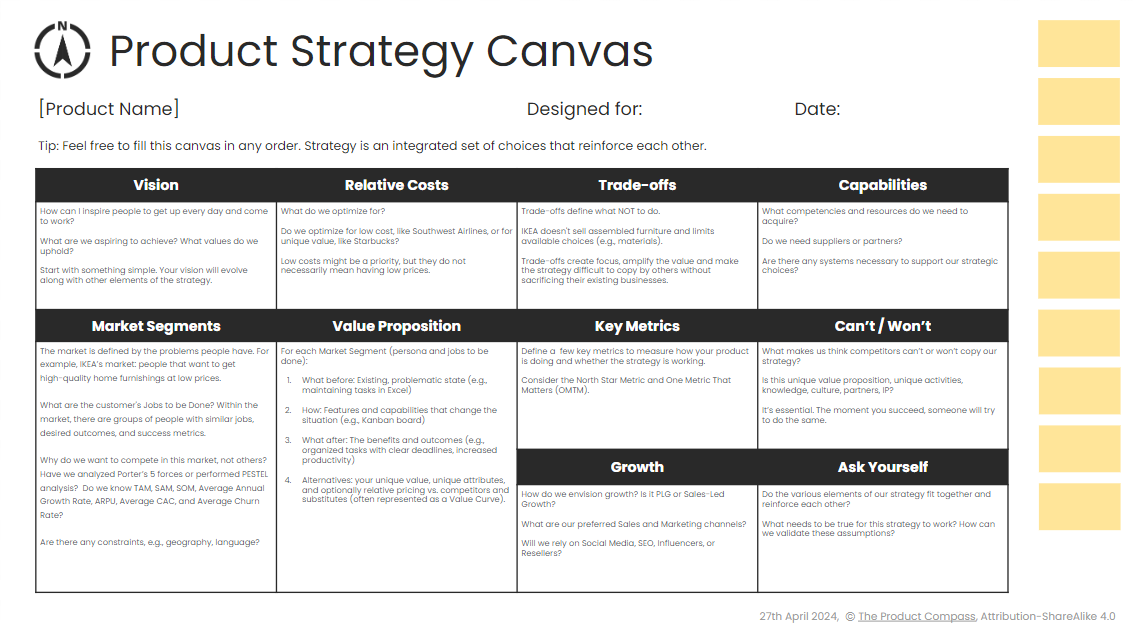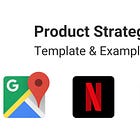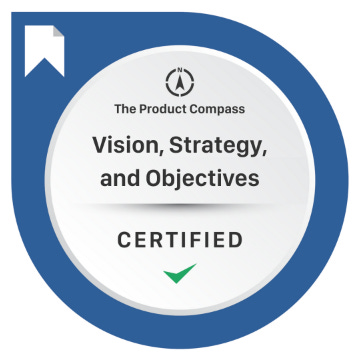Product Strategy Canvas
What is product strategy?
Understanding and implementing a product strategy is crucial for everyone in a product organization.
Product strategy is simple. But, contrary to common misconceptions, it’s not:
A plan (“we will build x, y, and z”).
A goal (“we want to grow by 50% by 2024”).
An ambition (“we want to be the best”).
An action (“disable that feature”).
An OKR.
A Business Model.
A Unique Value Proposition.
Many companies do not have a product strategy at all.
A good product strategy
Defines a long-term vision (winning aspiration)
Is a single, integrated set of choices that reinforce each other and increase your odds of success
Defines the market (problems) and your playing field’s constraints
Focuses on customers whom you can’t control
Has a theory on how to persuade them to do what you want
Explains what competencies, resources, and systems you need
Passes the Can’t/Won’t Test. Your competitors can’t or won’t copy it
Has many levels. In the context of product management, business strategy is an input for product strategy.
Allows you to formulate hypotheses
Introducing the Product Strategy Canvas: An essential tool for creating a product strategy
I couldn't find a single product strategy template I could recommend. So here is a new one (v1.2):

It's based primarily on the insights of industry experts Michael Porter and Roger Martin.
The Product Strategy Canvas defines:
1. Vision
How can I inspire people to get up every day and come to work? What are we aspiring to achieve? What values do we uphold?
Start with something simple. Your vision will evolve along with other elements of the strategy.
2. Market Segments
The market is defined by the problems people have. For example, IKEA’s market: people that want to get high-quality home furnishings at low prices.
What are the customers’ jobs to be done? Within the market, there are groups of people with similar jobs, desired outcomes, and success metrics.
Are there any constraints, e.g., geography, language?
What will be your first customer segment?
3. Relative Costs
What do we optimize for? Do we optimize for low cost, like Southwest Airlines, or for unique value, like Starbucks?
Low costs might be a priority, but they do not necessarily mean having low prices.
4. Value Proposition
For each Market Segment (persona and jobs to be done):
What before: Existing, problematic state (e.g., maintaining tasks in Excel)
How: Features and capabilities that change the situation (e.g., Kanban board)
What after: The benefits and outcomes (e.g., organized tasks with clear deadlines, increased productivity)
Alternatives: your unique value, unique attributes, and optionally relative pricing vs. competitors and substitutes (often represented as a Value Curve).
More: How to Design a Value Proposition Customers Can't Resist?
5. Trade-offs
Trade-offs define what NOT to do. For example, IKEA doesn't sell assembled furniture and limits available choices (e.g., materials).
Trade-offs create focus and amplify the value.
6. Key Metrics
Define a few key metrics to measure how your product is doing and whether the strategy is working.
Consider the North Star Metric and One Metric That Matters (OMTM).
7. Growth
How do we envision growth? Is it PLG or Sales-Led Growth?
What are our preferred Sales and Marketing channels? Will we rely on Social Media, SEO, Influencers, or Resellers?
8. Capabilities
What competencies and resources do we need to acquire?
Do we need suppliers or partners?
9. Can’t / Won’t
What makes us think competitors can’t or won’t copy our strategy? Is this unique value proposition, activities, knowledge, culture, partners, IP?
It’s essential. The moment you succeed, someone will try to do the same.
10. Ask Yourself
Do the various elements of our strategy fit together and reinforce each other?
What needs to be true for this strategy to work? How can we validate these assumptions?
Product Strategy Examples
See a dedicated post:
From Strategy to Objectives Masterclass
As a product leader, you need to answer:
What are you trying to achieve and why?
Where are you going to play?
How are you going to win?
And turn those choices into actions. The best companies lead with strategic context, empower their teams, and trust them to find the way forward.
From Strategy to Objectives Masterclass, launched in Sep 2024, is a self-paced video course.
You will:
Learn how to craft a strong product vision and strategy.
Access #1 Product Strategy Canvas (Google) and a dedicated Notion template.
Protect your strategy against competitive threats.
Lead your empowered product teams with strategic context.
Apply Objectives and Key Results (OKRs) in practice.
Get a digital, verifiable credential you can easily demonstrate after passing the exam.
My premium subscribers can access it for free.
How to work with a Product Strategy Canvas? The essential frameworks, examples, and templates.
Templates available under the Strategy and Business Templates section:
Product Strategy Canvas (PPTX)
Startup Canvas: Product Strategy and a Business Model (PPTX)
Business Model Canvas (PPTX)
Lean Canvas (PPTX)
Value Proposition Canvas (PDF)
Business Model Portfolio (PDF)
Lean UX Canvas (PDF)
Value Curve (XLSX)
Ansoff Matrix (Miro)
Porter’s Five Forces (PPTX)
PESTEL Analysis (Miro)
SWOT Analysis (Miro)
Related posts:
Jobs-to-be-Done Masterclass with Tony Ulwick and Sabeen Sattar
How to Achieve Product-Market Fit?
Books on Product Innovation with videos:
Books on Product Growth with videos:
Frequently Asked Questions
Q1: What is the role of vision in product strategy?
In product strategy, the vision sets the long-term aspiration for the product, guiding all strategic decisions. It answers critical questions about the product’s purpose, mission, and the values it upholds.
Some tend to split product vision and product strategy. But I’m persuaded by Roger Martin’s argument that you need to define your vision (“Winning Aspiration”) alongside the other elements of the strategy rather than consecutively.
Q2: How can the Product Strategy Canvas enhance my product development strategy?
There is no such thing as a “product development strategy.” You might be confusing the product development plan with strategy. But those are different terms.
The Product Strategy Canvas is a crucial tool in developing a product strategy, a set of bets you make to win at the playing field of your choice.
If you want to create a product development plan, here are the recommended techniques and a template.
Q3: Who benefits from using this product strategy framework?
Product teams, marketing teams, business strategists, and entrepreneurs benefit from using a product strategy framework.
It’s essential for anyone planning, launching, or managing a product.
Communicating the strategic context is a prerequisite to empowering people to make better autonomous decisions.
Q4: How often should a product strategy be reviewed?
A product strategy should be reviewed regularly, ideally quarterly, to adapt to market changes and evolving business objectives.
This ensures the strategy remains relevant and can be used to plan further your goals (e.g., Objectives and Key Results).
Q5: Is the Product Strategy Canvas suitable for different industries? Is it only a digital product strategy?
Absolutely, the Product Strategy Canvas is versatile and applicable across various industries, from tech to retail.
Its adaptability makes it a valuable tool for any product type, whether physical goods or digital services.
Q6: What are key metrics in product strategy?
Key metrics in product strategy are related to:
Creating value - the best approach is using the North Star Framework
Capturing value - metrics like revenue, churn, and revenue retention. For more examples, see The Ultimate List of Product Metrics.
Remember that value for the business lags behind value for the customers. So, the metrics you should focus on the most are in the first group.
That’s how the growth works.
Q7: Where can I find resources for a Product-Led Growth strategy? What is Product-Led Growth strategy?
I’d argue there is no such thing as a “Product-Led Growth strategy.” Because strategy is singular.
Some of the choices you make might be related to Product-Led Growth. The resources you might be looking for:
[Book] Hacking Growth (+video)
[Book] Product-Led Growth (+video)
[Book] Product-Led Onboarding (+video)
[Book] Hooked (+video)
[Book] Crossing the Chasm (+video)
[Free Course] Product-led Certification
Q8: Where can I find resources for a marketing strategy? What is marketing strategy?
I’d argue there is no such thing as a “marketing strategy.” Because strategy is singular.
Some of the choices you make might be related to marketing your product. See: Product Management vs. Product Marketing vs. Product Growth 101
Q9: How does product strategy differ from business modeling?
Product strategy focuses on a product’s strategic direction and choices, while business modeling covers the financial structure.
The business model evolves from the strategy. Both elements are crucial.
Popular templates, like the Business Model Canvas or the Lean Canvas, mix business models with strategy elements.
While having a single canvas might be fine for startups, the popular models miss a few critical elements, like the “What makes us think competitors can’t or won’t copy our product strategy” — the reason many startups succeed, to fail afterward.
Q10: What’s the difference between the value proposition and strategy?
The value proposition alone is not a strategy. Thus, The Blue Ocean Strategy Canvas is not a strategy canvas but a Value Curve. It’s just one of many elements of strategy.
This viewpoint aligns with the work of Prof. Roger Martin.
Additional notes
The Product Strategy Canvas is based primarily on the work of Michael Porter and Roger Martin, particularly their books Understanding Michael Porter and Playing to Win and articles.
In Bad Strategy & Good Strategy, Richard Rumelt suggested that strategy should contain Coherent Actions. I chose to exclude this idea as it does not align with the definitions provided by Porter and Martin. They posited that a strategy is an integrated set of choices, not a plan or a set of activities.
Some distinguish between Product Vision and Product Mission. Vision and Mission are often interchanged, causing confusion. I advocate using a single term because I don't see any value in separating these statements. I've explained this in more detail in this post. I also recommend reading an article by Prof. Roger Martin. You can also see how LinkedIn confuses those terms.
Versioning:
Version 1.2 was released on 27th April 2024 (current version)
Version 1.1 was released on 3rd Aug 2023
Version 1.0 was released on 26th Jan 2023




